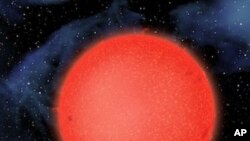Astronomers using the Hubble space telescope have discovered a new kind of planet in the galaxy - a world 40 light years beyond our solar system with a dense atmosphere that surrounds a surface covered entirely by an ocean of super-hot water.
In our solar system, there are three types of planets - rocky terrestrial worlds, including Earth, Mars, Venus and Mercury, gas giants such as Jupiter and Saturn and the ice giants of Uranus and Neptune.
Outside the solar system, newer observational techniques have led to the discovery of previously unknown kinds of exo-planets, including lava worlds and so-called “hot Jupiters” orbiting their stars.
Now, astronomers at the Harvard-Smithsonian Center for Astrophysics in Massachusetts, using the orbiting Hubble space telescope, have spied a distant planet, more than twice the size of Earth and weighing seven times as much, covered entirely in super-hot water.
The planet, called GJ 1214b, is located a mere 40 light years away, a short distance in cosmic terms.
Originally discovered in 2009, further observations by the scientists using the Hubble Space Telescope have revealed the water world is entirely enshrouded by a thick, steamy atmosphere.
Because the watery exo-planet orbits its star, a small red-dwarf, every 38 hours at a close distance of more than two million kilometers, scientists estimate the rocky but wet planet has an exterior temperature of more than 232 degrees Celsius, like that of a really hot oven, according to lead investigator Zachory Berta, with highly unusual surface features.
“Part of the planet might be what’s known as like hot ice, this weird form of water that’s solid but at very high temperatures, hotter than the normal boiling point of water," said Berta. "And you could also have this weird like super-fluid water, ionized water, all of these very strange molecule form of water making up the planet. But it would be very different from an Earth-like ocean.”
Astronomers used a wide field camera mounted on Hubble to study GJ 1214b as it transited in front of its host star, to measure the infrared light of the planet’s sunset.
During the transit, the star’s light is filtered into different colors that give clues into the chemical make-up of GJ 1214b’s atmosphere.
Astronomers also looked to see how puffy or compact the planet’s atmosphere was, something Berta says clinched the water analysis.
“We thought at first that the atmosphere could be made up of a lot of hydrogen and helium," he said. "And that would make a very puffy atmosphere that comes out around the planet a very long ways. And that’s not what we found. We found that it was a much more compact atmosphere that it was much closer in to the planet. And so the easiest molecule you can think to do that would a heavier molecule like water that would pull the atmosphere down into the planet.”
Astronomers think GJ 1214b has a watery atmosphere and surface because it originally formed far from its host star, where water ice was plentiful, and then gravitated toward its sun.
Berta says scientists are anxious to find other water worlds and what he calls “weird” exo-planets beyond the solar system.
An article on the watery exo-planet GJ 1214b is published in Astrophysical Journal.
Hubble Astronomers Discover Exo-Planet Covered Entirely by Super-Hot Water












